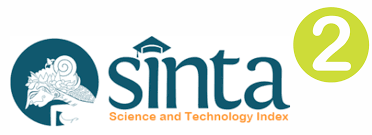Author Guidelines
Download author guidlines.
INTRODUCTION
Master’s Degree of Communication Science, University of Bunda Mulia University, periodically publishes BRICOLAGE: Jurnal Magister Ilmu Komunikasi. This journal is intended to accommodate the variety of thoughts of postmodernism studies, especially from the perspective of communication science and does not rule out the possibility of crossing perspectives that appreciate human nobility through various mediums. BRICOLAGE: Jurnal Magister Ilmu Komunikasi is an ideal forum for disseminating research results as well as scientific works in the following scientific fields: (1) Corporate Communication; (2) Marketing & Tourism Communication; (3) Media Studies; (4) Cultural Studies; (5) Feminism Studies; and (6) Philosophy of Communication. Furthermore, BRICOLAGE: Jurnal Magister Ilmu Komunikasi is intended to publish scientific results that are expected to provide added value for the development of theoretical domains, practical applications, case studies, and cross-time studies on various documents that enlighten the public. Each scientific work received by the editor, will be continued by the editorial team BRICOLAGE: Jurnal Magister Ilmu Komunikasi, then assessed by two peer-reviewers or by double-blind review system who are unknown by the author of the work. The final decision about the scientific feasibility of a scientific paper to be published is entirely the decision of the editorial board. BRICOLAGE: Jurnal Magister Ilmu Komunikasi is published twice a year, in March and September. The articles published using Bahasa Indonesia and/or English, each of which will be processed by a team of editors and peer-reviewers who have qualified language skills according to the origin of the work institution and the alma mater where they obtain their highest academic degree. In view of the BRICOLAGE: Jurnal Magister Ilmu Komunikasi is at the master level, so in order to maintain the quality of our publications it is determined that the expert review team or sustainable partners have completed a three-level education (3) with the title Dr./Ph.D. and have a reputable research experience or track record (SCOPUS ID).
WRITING FORMAT
Writing Organization
Articles use Microsoft Word software (MS.Word) 1997-2003 in A4 size, then the text is typed in one (1) space. The fonts are based on Times New Roman measuring 11pt and single column, in contrast to the inclusion of graphics, tables, and images that must be in one column (one column layout). Furthermore, the length of the manuscript is around 17-22 pages with the top, bottom, left, and right margins equal to 3 centimeters (3cm). The results section and discussion can be added subtitles written in Times New Roman font 11 and bold, the new paragraph is written inward, between paragraphs not spaced.
Topic and Title
The title of the scientific work is stated in a minimum of 10 words and a maximum of 15 words are made in two languages (Indonesian and English). After the title, followed by the inclusion of the full name of the author without abbreviating (not including an academic degree), the department's identity (please choose one: Faculty / Study Program / Bureau / Division) from the closest line in the author's hierarchy position line and separate commas (, ) continued with the institution's identity (can be chosen by one: University / Institute / High School / Institution / Institution) where the author works, then lists the e-mail address as the medium of reader correspondence with the author at the very bottom of the first page. The focus of the article is aimed at the study of postmodernism from the perspective of communication science or other scientific rules, reflected in the topic and its title, while the technical division includes the following:
Abstract
Self-explanatory summary of research results, without too detailed explanation. Abstract fonts are Times New Roman with a 10pt font size in one (1) paragraph and contain a minimum of 150 to a maximum of 200 words, the essence is accompanied by a maximum of 5 (five) keywords or phrases, and must contain: (1) Background , research problems; (2) Research objectives; (3) The research method used; (5) Research results; (6) Conclusion of research in achieving research objectives. The proportion of research identity starting from the title, the identity of the author, to abstraction in two languages, is in the scope of as much as 6% or about one (1) page of the total manuscript.
Introduction
Contains preamble of research that has a proportion of 25% or about four (4) pages of the total manuscript. Contains background problems, research problems, problems (problems) research, clear literature review, and research objectives.
Research Method
This research foundation or research rule has a proportion of 12% or about two (2) pages of the total manuscript. Include research paradigms, types of studies conducted, data collection techniques and data analysis.
Results and Analysis
The essence of this research finding has a proportion of 38% or about seven (7) pages of the total manuscript. Express research findings clearly, containing tables, graphics, and images that are interpreted and elaborated with relevant literature.
Conclusion
The final part of this research report has a proportion of 7% or about one (1) page of the total manuscript. Conclude research that has the ability to represent the main findings and have meaningful recommendations.
References
The final part of this research report has a proportion of 12% or about two (2) pages of the total manuscript. Reflect the adequacy and novelty of reference literature by prioritizing scientific journals (80%) as a foothold of a minimum of 12 citations.
OTHER TECHNICAL THINGS
The author is asked to attach "RECORD OF WRITERS" containing the author's figure and work in a short formula, between 100 and 150 words in two languages, namely: Indonesian and English. Manuscripts are sent via the Open Journal System (OJS) BRICOLAGE: Jurnal Magister Ilmu Komunikasi (https://journal.ubm.ac.id/index.php/bricolage/login) which is managed by the Master of Communication Studies Program, Postgraduate Program of the University of Bunda Mulia - Jl. Lodan Raya no. 2, Jakarta 14430.





























.png)

